A Proposal of a Method for Ready-Mixed Concrete Quality Assessment Based on Statistical-Fuzzy Approach
Abstract
1. Introduction
Quality Control of Ready-Mixed Concrete According to EN-206
- (1)
- Individual assessment result criterion fci—applied irrespective of the production status (initial or continuous)
- (2)
- Mean assessment result criterion fcm—applied in three methods depending on the production status:
- –
- Initial production
- –
- Continuous production
- –
- The concept of control chart—method C.
- —test coefficient value set out by the standard [28],
- —standard deviation for population.
- The concrete acceptance probability is not always a compromise between the producer risk and the customer risk. Applying the standard conformity criteria may lead to an excessive customer risk, especially in the case of an assumption of log-normal distribution of compressive strength.
- Applying the standard conformity criteria may lead the producer to adopting strategies involving higher production costs, as it can unnecessarily require higher mean values of production with higher standard deviations. These criteria are not recommended for production with small deviation and may be a reason for concealing the results for samples of understated compressive strength.
- Applying the standard conformity criteria may produce too high values of the consumer risk.
2. Materials and Methods
2.1. Conformity Control of Concrete Compressive Strength in Consideration of Measurement Uncertainty
2.2. Alternative Conformity Criteria for Concrete Compressive Strength
- –
- For method A and sample of size n = 15, (9):where fcm is the mean compressive strength of concrete, and fck is the characteristic compressive strength of concrete.
- –
- For method B and sample of size n ≥ 15, (10):where fcm is the mean compressive strength of concrete, fck is the characteristic compressive strength of concrete, σ-estimate for the standard deviation of a population.
- Generate N groups of random numbers of size n = 3 from normal distribution;
- Randomly select concrete class—Concrete of three adjacent classes Ci−1, Ci, Ci+1 (identical probability of 1/3);
- Randomly select standard deviation from 2, 3, 4, 5, 6 MPa with 1/5 probability;
- Repeat (1) and (2) n-times to obtain fci,…, fcn;
- Randomly select defectiveness w from normal distribution;
- Calculate mean compressive strength of adjacent concrete classes from Equation (11):
- Calculate standard deviation from Equation (12):
- Determine the characteristic compressive strength for the considered and lower concrete classes from Equation (13):and for the considered and higher concrete classes from Equation (14):
- Calculate mean compressive strength of the considered and lower concrete classes from Equation (15):and of the considered and higher concrete classes from Equation (16):
- Create a table for the probability distribution function of random vector (ξ, η) and determine the histogram of marginal distributions by summing rows and columns. The first marginal distribution is the sum of rows and the classification by the considered and lower concrete classes. The second marginal distribution is the sum of columns and the classification by the considered and higher concrete classes.
2.3. Example of Application of the Statistical-Fuzzy Conformity Criteria for Concrete of Class C20/25
3. Results and Discussion
4. Conclusions
- The proposed concept of quality assessment allows for minimising the risk of wrong classification of a concrete batch, i.e., overstating or understating the concrete class.
- Employing non-standard methods of conformity control of concrete compressive strength may become a useful tool in the investment-related (technology-related) decision-making process.
- The analyses carried out reveal that the statistical-fuzzy conformity control can play an arbitrary role in the quality assessment of the concrete produced.
- Statistical-fuzzy and fuzzy methods allow to take into account the opposing requirements of safety, quality and economy. Taking these requirements into consideration is made possible by determining a degree of membership lower than 1 for the considered concrete class.
- The alternative method of concrete quality assessment is easy to apply; however, it requires a complex calculation procedure, which significantly limits its universal use in the production process. Widespread application of this method would require implementing specialised utility software developed based on specific algorithms.
- The advantages of the statistical-fuzzy approach are particularly observable when employing the concept of concrete families. It allows to minimise the uncertainty connected to the transformation relation between the results for compressive strength of each concrete family member.
- Based on this approach, a risk matrix may be developed for a construction facility in order to verify the assigned reliability class specified in the construction design.
- Statistical-fuzzy methods are fully compatible with the concept of sustainable construction. Accidental understating of the concrete class results in the rejection of a concrete batch by the recipient. An unsuitable concrete mix is then considered as construction waste, which contradicts the principles of rational use of construction materials and mineral resources.
Author Contributions
Funding
Conflicts of Interest
References
- Krzemiński, M. Optimization of Work Schedules Executed Using the Flow Shop Model, Assuming MultiTasking Performed by Work Crews. Arch. Civ. Eng. 2017, 63, 3–19. [Google Scholar] [CrossRef]
- Leśniak, A.; Zima, K. Cost Calculation of Construction Projects including Sustainability Factors Using the Case Based Reasoning (CBR) Method. Sustainability 2020, 10, 1608. [Google Scholar] [CrossRef]
- Sztubecka, M.; Skiba, M.; Mrówczyńska, M.; Bazan-Krzywoszańska, A. An Innovative Decision Support System to Improve the Energy Efficiency of Buildings in Urban Areas. Remote Sens. 2020, 12, 259. [Google Scholar] [CrossRef]
- Nazarko, L. Technology Assessment in Construction Sector as a Strategy towards Sustainability. Procedia Eng. 2015, 122, 290–295. [Google Scholar] [CrossRef][Green Version]
- Lee, D.; Lee, D.; Lee, M.; Kim, M.; Kim, T. Analytic Hierarchy Process-Based Construction Material Selection for Performance Improvement of Building Construction: The Case of a Concrete System Form. Materials 2020, 13, 1738. [Google Scholar] [CrossRef]
- Project Management Institute. A Guide to the Project Management Body of Knowledge (PMBOK Guaid); Project Management Institute: Philadelphia, PA, USA, 2000. [Google Scholar]
- Arditi, D.; Gunaydin, H.M. Total Quality Management in the Construction Process. Int. J. Proj. Manag. 1997, 15, 235–243. [Google Scholar] [CrossRef]
- Kowalski, D. Quality Assurance of Works and Materials in Construction Projects. Inżynieria Morska I Geotech. 2013, 5, 362–365. [Google Scholar]
- Gursel, A.P.; Masanet, E.; Horvath, A.; Stadel, A. Life-Cycle Inventory Analysis of Concrete Production: A Critical Review. Cem. Concr. Compos. 2014, 51, 38–48. [Google Scholar] [CrossRef]
- Poon, C.S.; Yu, A.T.W.; Jaillon, L. Reducing Building Waste at Construction Sites in Hong Kong. Constr. Manag. Econ. 2004, 22, 461–470. [Google Scholar] [CrossRef]
- Hilburg, J. Concrete Production Produces Eight Percent of the World’s Carbon Dioxide Emissions. Architecture, International, News, Sustainability. Available online: https://www.archpaper.com/2019/01/concrete-production-eight-percent-co2-emissions/ (accessed on 20 August 2020).
- Ready-Mixed Concrete Industry Statistics. Available online: https://mediatheque.snpb.org/userfiles/file/Statistics%20Bound%20Volume%2030_08_2019%20-%20R4.pdf (accessed on 16 July 2020).
- Gorzelanczyk, T.; Pachnicz, M.; Rozanski, A.; Schabowicz, K. Identification of Microstructural Anisotropy of Cellulose Cement Boards by Means of Nanoindentation. Constr. Build. Mater. 2020, 57, 119515. [Google Scholar] [CrossRef]
- Chen, S.T.T.; Wang, W.C.; Wang, H.Y. Mechanical Properties and Ultrasonic Velocity of Lightweight Aggregate Concrete Containing Mineral Powder Materials. Constr. Build. Mater. 2020, 258, 119550. [Google Scholar] [CrossRef]
- Widianto, A.K.; Wiranegara, J.L.; Hardjito, D. Consistency of Fly Ash Quality for Making High Volume Fly Ash Concrete. J. Teknol. 2017, 79, 13–20. [Google Scholar]
- Mazur, W.; Drobiec, Ł.; Jasiński, R. Research of Light Concrete Precast Lintels. Procedia Eng. 2016, 161, 611–617. [Google Scholar] [CrossRef]
- Debieb, F.; Courard, L.; Kenai, S.; Degeimbre, R. Mechanical and Durability Properties of Concrete Using contaminated Recycled Aggregates. Cem. Concr. Compos. 2010, 32, 421–426. [Google Scholar] [CrossRef]
- Dobiszewska, M.; Beycioglu, A. Investigating the Influence of Waste Basalt Powder on Selected Properties of Cement Paste and Mortar. Mater. Sci. Eng. 2017, 245, 022027. [Google Scholar] [CrossRef]
- Sonebi, M.; Ammar, Y.; Diederich, P. Sustainability of Cement, Concrete and Cement Replacement Materials in Construction. In Sustainability of Construction Materials; Woodhead Publishing: Cambridge, UK, 2016; pp. 371–396. [Google Scholar]
- Beycioglu, A.; Basyigit, C. Rule-Based Mamdani-Type Fuzzy Logic Approach to Estimate Compressive Strength of Lightweight Pumice Concrete. Acta Phys. Pol. 2015, 128, 424. [Google Scholar] [CrossRef]
- Skrzypczak, I.; Kokoszka, W.; Buda-Ożóg, L.; Janusz Kogut, J.; Słowik, M. Environmental Aspects and Renewable Energy Sources in the Production of Construction Aggregate. In E3S Web of Conferences; EDP Sciences: Ulis, France, 2017; p. 00160. [Google Scholar]
- Al Ajmani, H.; Suleiman, F.; Abuzayed, I.; Tamini, A. Evaluation of Concrete Strength Made with Recycled Aggregate. Buildings 2019, 9, 56. [Google Scholar] [CrossRef]
- Czarnecki, L.; Hager, T.; Tracz, T. Material Problems in Civil Engineering: Ideas-Driving Forces-Research Arena. Procedia Eng. 2015, 108, 3–12. [Google Scholar] [CrossRef][Green Version]
- Dobiszewska, M. Waste Materials Used in Making Mortar and Concrete. J. Mater. Educ. 2017, 39, 133–156. [Google Scholar]
- Patil, S.V.; Rao, K.B.; Nayak, G. Quality Improvement of Recycled Aggregate Concrete using six sigma DMAIC methodology. Int. J. Math. Eng. Manag. Sci. 2020, 5, 1409–1419. [Google Scholar]
- Wang, D.; Liu, G.; Li, K.; Wang, T.; Shrestha, A.; Martek, I.; Tao, X. Layout Optimization Model for the Production Planning of Precast Concrete Building Components. Sustainability 2018, 10, 1807. [Google Scholar] [CrossRef]
- Domagała, L. Durability of Structural Lightweight Concrete with Sintered Fly Ash Aggregate. Materials 2020, 13, 4565. [Google Scholar] [CrossRef] [PubMed]
- Słoński, M.; Schabowicz, K.; Krawczyk, E. Detection of Flaws in Concrete Using Ultrasonic Tomography and Convolutional Neural Networks. Materials 2020, 13, 1557. [Google Scholar] [CrossRef] [PubMed]
- Schabowicz, K. Non-Destructive Testing of Materials in Civil Engineering. Materials 2019, 12, 3237. [Google Scholar] [CrossRef] [PubMed]
- Abousnina, R.; Manalo, A.; Ferdous, W.; Lokuge, W.; Benabed, B.; Al-Jabri, K.S. Characteristics, Strength Development and Microstructure of Cement Mortar Containing Oil-ContaminatedS. Constr. Build. Mater. 2020, 252, 119155. [Google Scholar] [CrossRef]
- Ferdous, W.; Manalo, A.; Khennane, A.; Kayali, O. Geopolymer Concrete-Filled Pultruded Composite Beams–Concrete Mix Design and Application. Cem. Concr. Compos. 2015, 58, 1–13. [Google Scholar] [CrossRef]
- EN 206: 2016 Concrete. Specification, Performance, Production and Conformity; Polish Committee for Standardization: Warsaw, Poland, 2014.
- Skrzypczak, I.; Kokoszka, W. Sustainable Methods for Assessing Conformity of Concrete Strength. J. Civ. Eng. Environ. Archit. 2015, 62, 403–408. (In Polish) [Google Scholar]
- Taerwe, L. Evaluation of Compound Compliance Criteria for Concrete Strength. Mater. Struct. 1988, 21, 13–20. [Google Scholar] [CrossRef]
- Skrzypczak, I.; Woliński, S. Influence of Distribution Type on the Probability of Acceptance of Concrete Strength. Arch. Civ. Eng. 2007, 53, 479–495. [Google Scholar]
- Casspeele, R.; Taerwe, L. Conformity Control of Concrete Based on the “Concrete Family” Concept. Beton Stahlbetonbau 2008, 103, 50–56. [Google Scholar] [CrossRef][Green Version]
- Skrzypczak, I.; Buda-Ożóg, L.; Pytlowany, T. Fuzzy Method of Conformity Control for Compressive Strength of Concrete on the Basis of Computational Numerical Analysis. Meccanica 2016, 51, 383–389. [Google Scholar] [CrossRef][Green Version]
- Holicky, M.; Vorlicek, M. Fractile Estimation and Sampling Inspection in Building. Acta Polytech. 1992, 32, 87–96. [Google Scholar]
- Zadeh, L.A. Fuzzy Sets and Information Granularity. Adv. Fuzzy Set Theory Appl. 1979, 11, 3–18. [Google Scholar]
- ISO/IEC. 17025:2017 General Requirements for the Competence of Testing and Calibration Laboratories; Technical Committee: ISO/CASCO Committee on Conformity Assessment: Geneva, Switzerland, 2017. [Google Scholar]
- Caltarino, J.M.R. Statistical Criteria for Acceptance of Materials Performance of Concrete Standards. In Proceedings of the ENV 206:1993 and EN 206, 12th ERMCO Congress Lisbon, Lisbon, Portugal, 23–26 June 1998; Volume 1. [Google Scholar]
- Li, H.; Yen, V.C. Fuzzy Sets and Fuzzy Decision-Making; CRC Press: Boca Raton, FL, USA, 1995. [Google Scholar]
- Woliński, S. Statistical and Fuzzy Compatibility Criteria of Compressive Strength of Concrete; Cracow University of Technology: Cracow, Poland, 1999. [Google Scholar]
- Brandt, S. Data Analysis; PWN: Warsaw, Poland, 1998. (In Polish) [Google Scholar]
- CEN. CR 13901:2000 The Use of the Concept of Concrete Families for the Production and Conformity Control of Concrete; CEN Technical Report; National Standards Authority of Ireland: Dublin, Ireland, 2000. [Google Scholar]
- Neshat, M.; Adeli, A.; Sepidnam, G.; Sargolzaei, M. Comparative Study on Fuzzy Inference System for Prediction of Concrete Compressive Strength. Int. J. Phys. Sci. 2012, 7, 440–456. [Google Scholar]
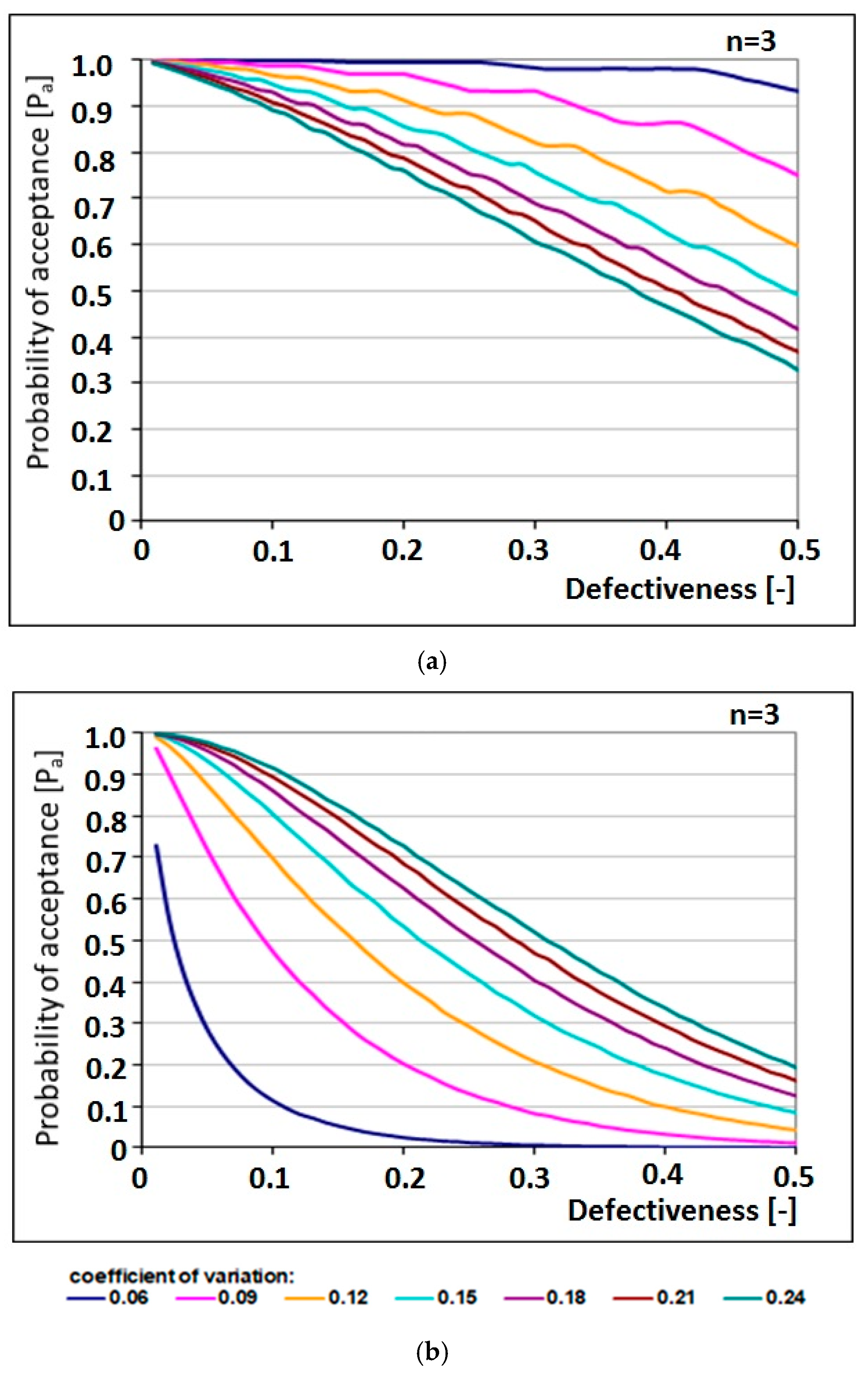
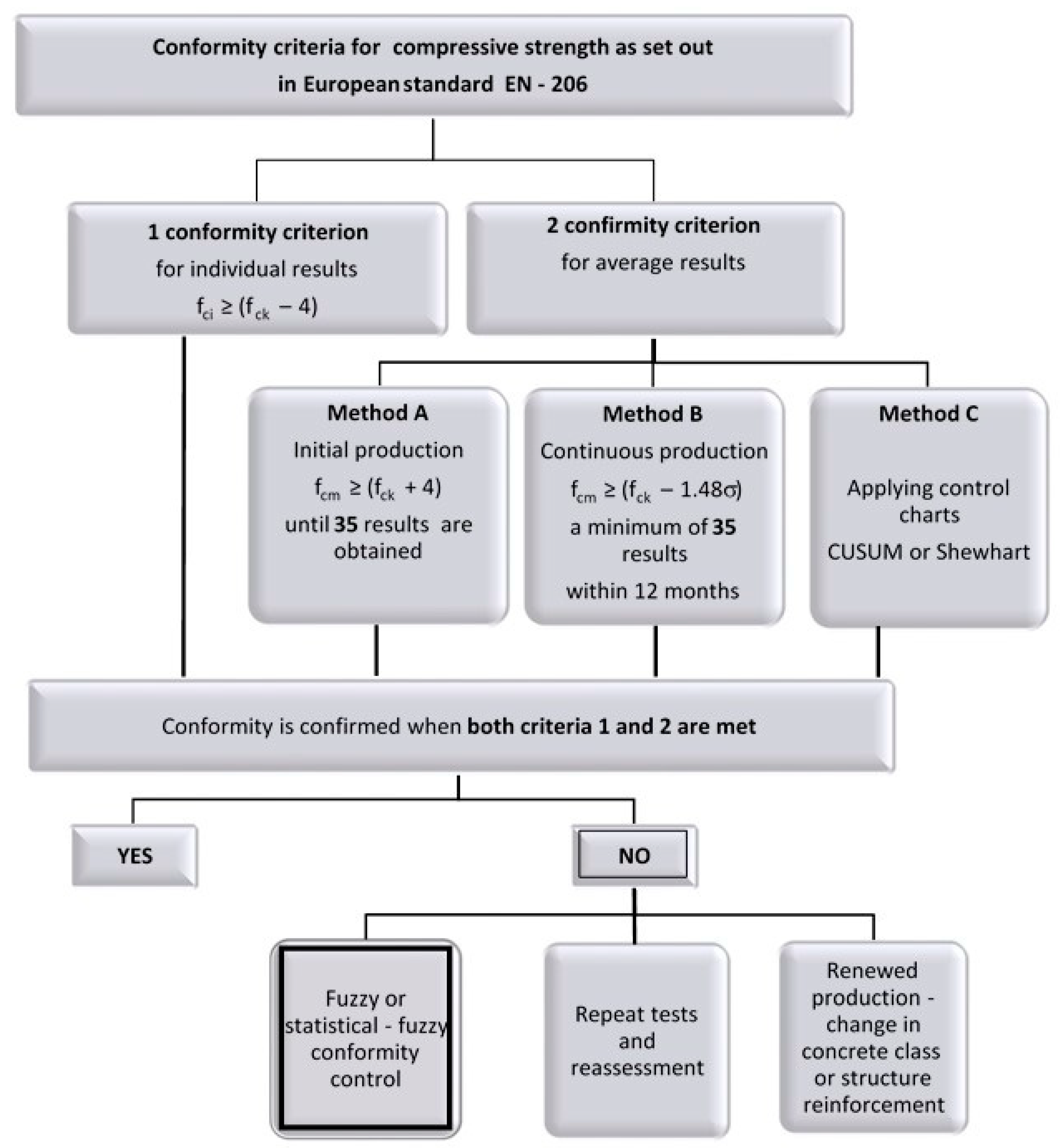
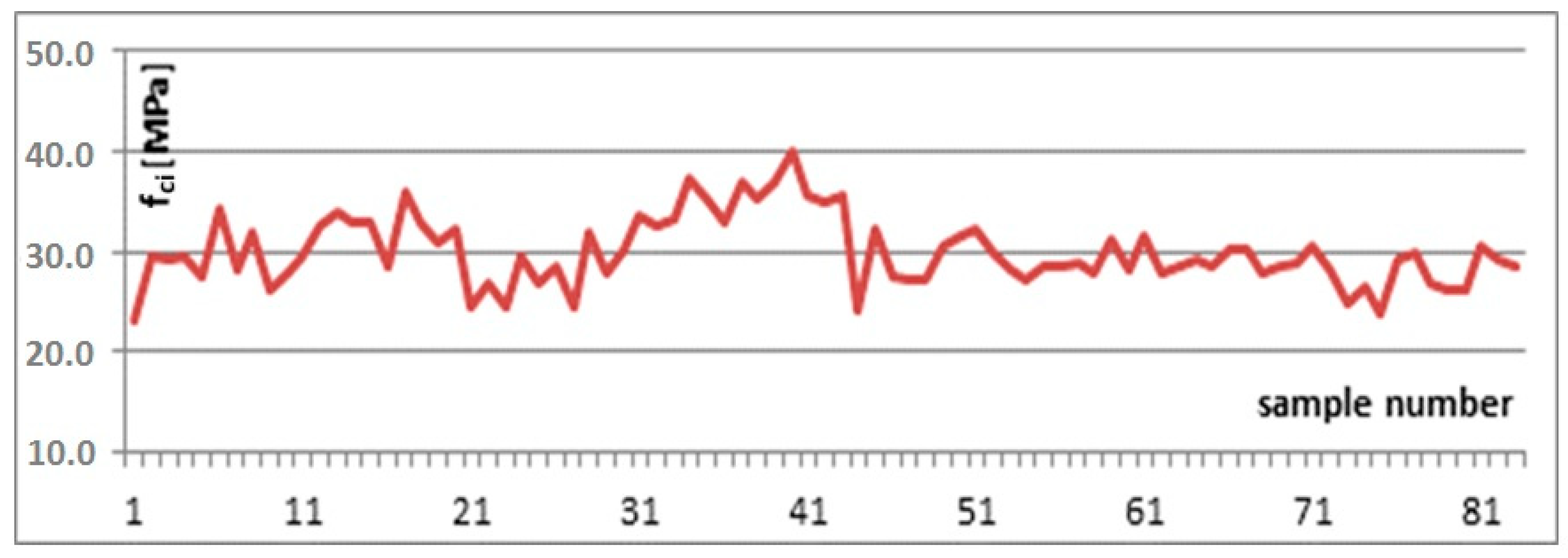
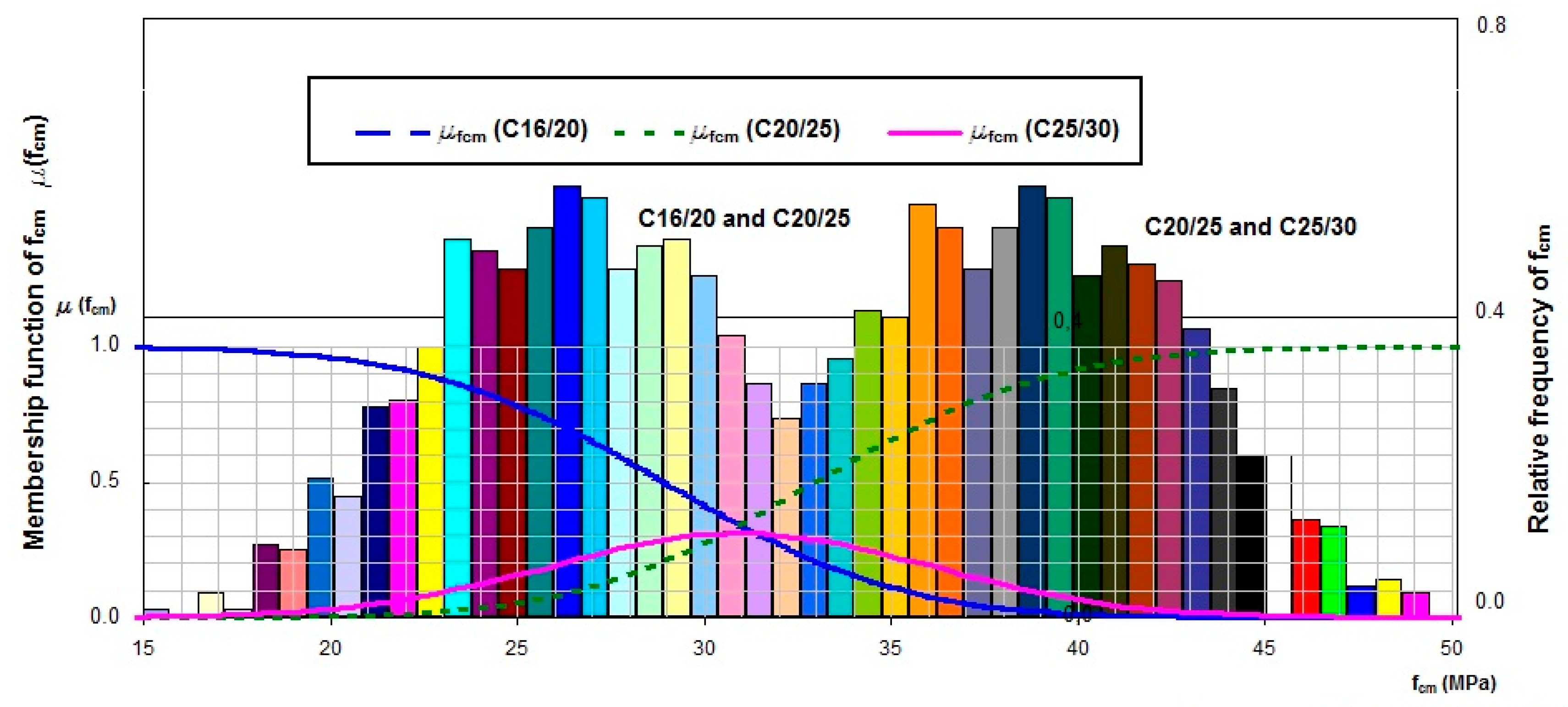
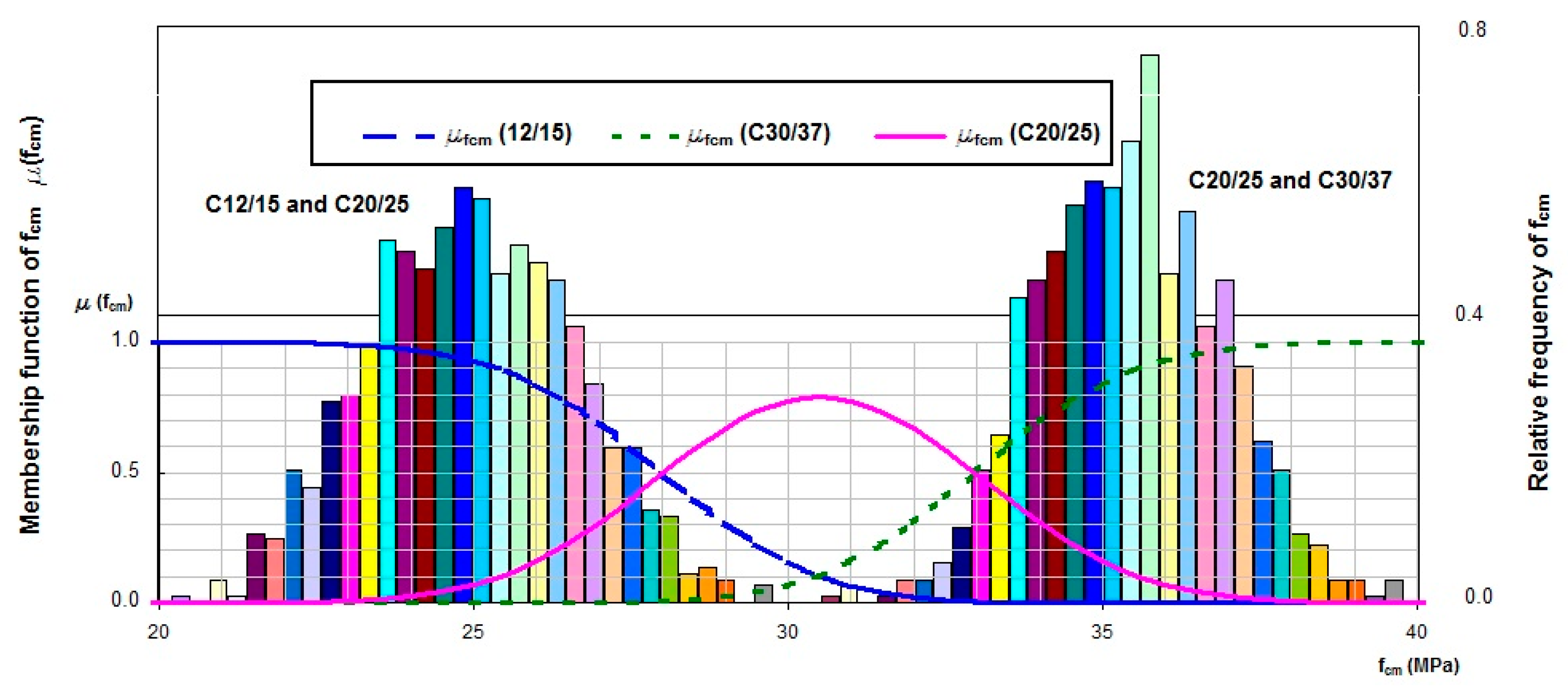
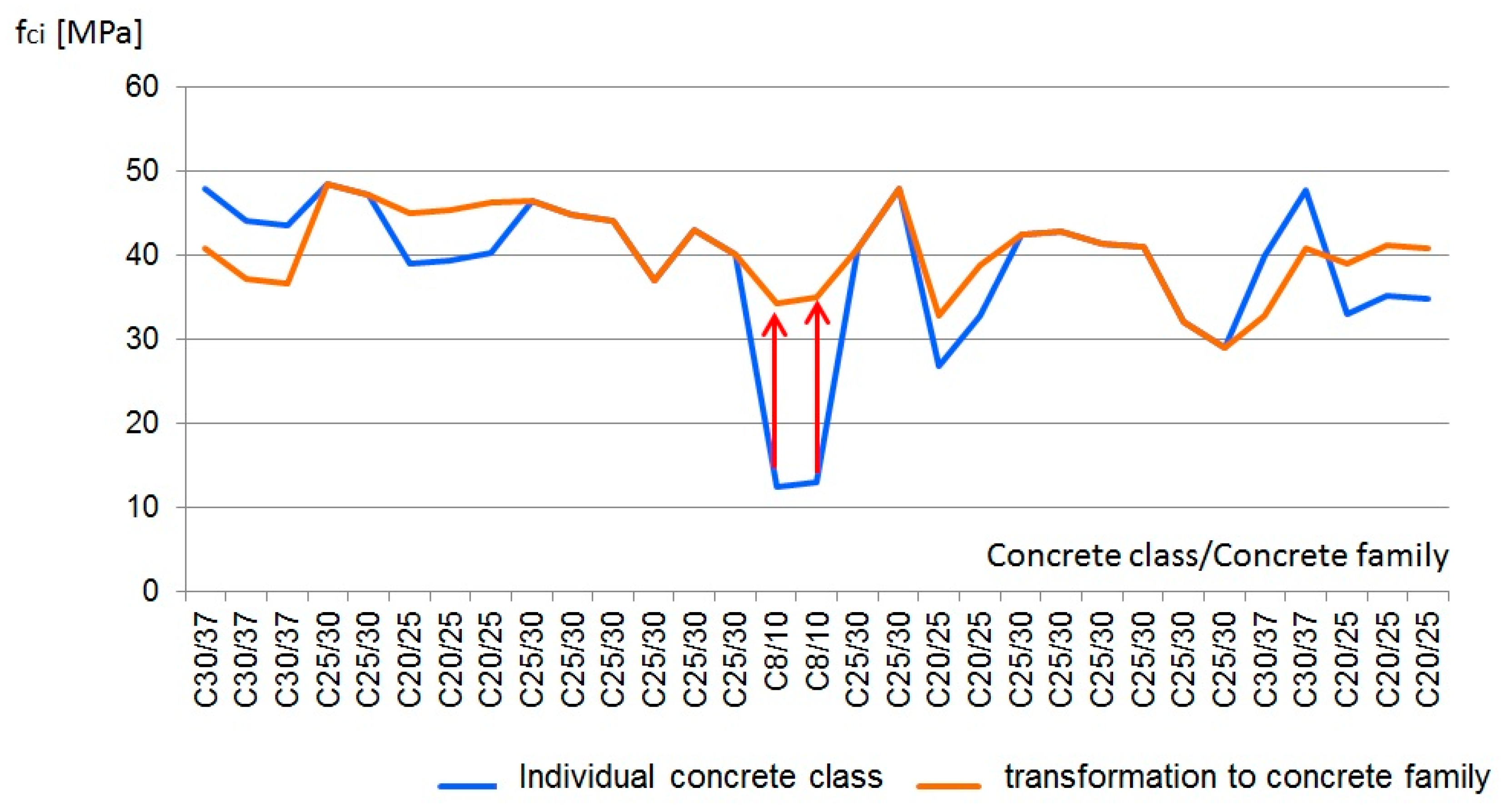
| Number (n) of Results | Value λ′ |
|---|---|
| 3 | 2.67 |
| 15 | 1.48 |
| Number Sample | Compressive Strength | Criterion 1 | Assessment | Criterion 2 | Assessment | Compressive Strength + Uncertainty | Criterion 2 + Uncertainty | Assessment |
|---|---|---|---|---|---|---|---|---|
| [-] | fci [MPa] | fci [MPa] | [-] | fcm [MPa] | [-] | fci [MPa] | fci min [MPa] | [-] |
| 1 | 23.1 | 23.1 | met | - | 24.2 | - | ||
| 2 | 29.7 | 29.7 | met | - | 30.8 | - | ||
| 3 | 29.1 | 29.1 | met | 27.3 | unmet | 30.2 | 28.4 | unmet |
| 4 | 29.5 | 29.5 | met | 29.4 | met | 30.6 | 30.5 | met |
| 5 | 27.5 | 27.5 | met | 28.7 | unmet | 28.6 | 29.8 | met |
| 6 | 34.3 | 34.3 | met | 30.4 | met | 35.4 | 31.5 | met |
| 7 | 28.1 | 28.1 | met | 30.0 | met | 29.2 | 31.1 | met |
| 8 | 31.9 | 31.9 | met | 31.4 | met | 33.0 | 32.5 | met |
| 9 | 26.1 | 26.1 | met | 28.7 | unmet | 27.2 | 29.8 | met |
| 10 | 28.0 | 28.0 | met | 28.7 | unmet | 29.1 | 29.8 | met |
| 11 | 29.4 | 29.4 | met | 27.8 | unmet | 30.5 | 28.9 | unmet |
| 12 | 32.6 | 32.6 | met | 30.0 | met | 33.7 | 31.1 | met |
| 13 | 33.8 | 33.8 | met | 31.9 | met | 34.9 | 33.0 | met |
| 14 | 33.0 | 33.0 | met | 33.1 | met | 34.1 | 34.2 | met |
| 15 | 32.8 | 32.8 | met | 33.2 | met | 33.9 | 34.3 | met |
Publisher’s Note: MDPI stays neutral with regard to jurisdictional claims in published maps and institutional affiliations. |
© 2020 by the authors. Licensee MDPI, Basel, Switzerland. This article is an open access article distributed under the terms and conditions of the Creative Commons Attribution (CC BY) license (http://creativecommons.org/licenses/by/4.0/).
Share and Cite
Skrzypczak, I.; Kokoszka, W.; Zięba, J.; Leśniak, A.; Bajno, D.; Bednarz, L. A Proposal of a Method for Ready-Mixed Concrete Quality Assessment Based on Statistical-Fuzzy Approach. Materials 2020, 13, 5674. https://doi.org/10.3390/ma13245674
Skrzypczak I, Kokoszka W, Zięba J, Leśniak A, Bajno D, Bednarz L. A Proposal of a Method for Ready-Mixed Concrete Quality Assessment Based on Statistical-Fuzzy Approach. Materials. 2020; 13(24):5674. https://doi.org/10.3390/ma13245674
Chicago/Turabian StyleSkrzypczak, Izabela, Wanda Kokoszka, Joanna Zięba, Agnieszka Leśniak, Dariusz Bajno, and Lukasz Bednarz. 2020. "A Proposal of a Method for Ready-Mixed Concrete Quality Assessment Based on Statistical-Fuzzy Approach" Materials 13, no. 24: 5674. https://doi.org/10.3390/ma13245674
APA StyleSkrzypczak, I., Kokoszka, W., Zięba, J., Leśniak, A., Bajno, D., & Bednarz, L. (2020). A Proposal of a Method for Ready-Mixed Concrete Quality Assessment Based on Statistical-Fuzzy Approach. Materials, 13(24), 5674. https://doi.org/10.3390/ma13245674








